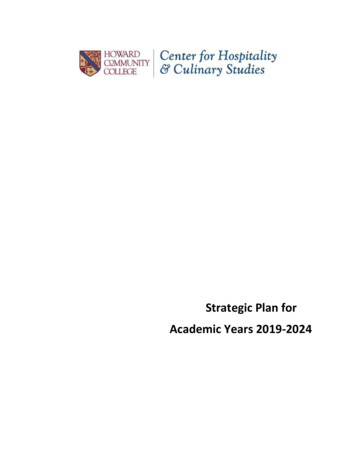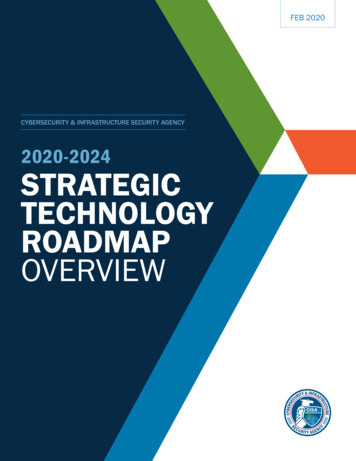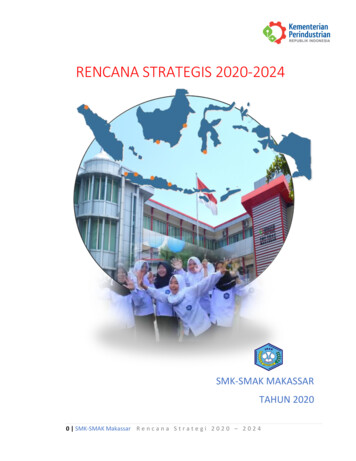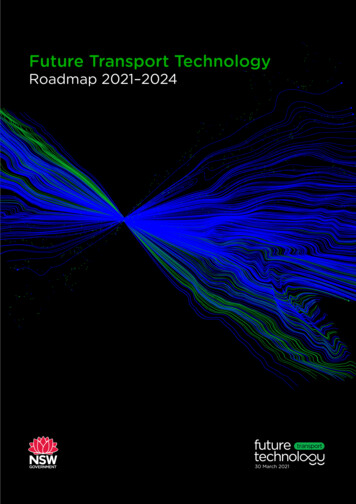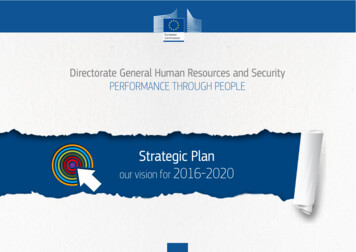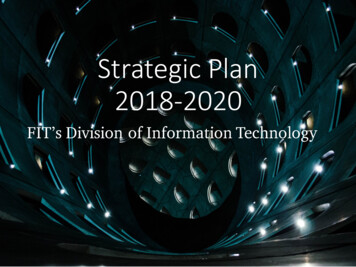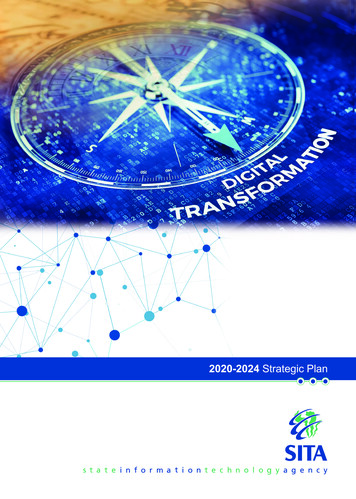
Transcription
2020-2024 Strategic Plan
11ApprovalIt is hereby certified that this strategic plan was developed by the management of State Information Technology Agency SOCLtd and takes into account all the relevant policies, legislation and other mandates for which the agency is responsible. Itaccurately reflects the strategic outcome-oriented goals and objectives which the agency will endeavour to achieve over theperiod 2020-2024.28 February 2019Chief Financial Officer (Acting) – Mr A Pretorius Date28 February 2019Chief Executive Officer – Dr S Mohapi Date28 February 2019Chairman: Board of Directors – Mr Z Nomvete Date
2ForewordBY THE CHAIRMANeconomy both seen as two significant government outcomeswhich impact positively on the advent of the fourth industrialrevolution. Managing public service processes and accessinggovernment services is made easier by a digitally transformedgovernment for the convenience of the citizens which buildsupon the social compact.The assertion by government that the state of education inSouth Africa among others will benefit from the deploymentof technology serves as justification for the existence of SITA,and brings into focus the role that technology should beplaying in the improvement of public services, primordiallylooking at the critical sectors, which are: education, health,social development, and security clusters.As a state Agency on Information and CommunicationsTechnology, SITA has reinvented itself in the last five yearsto assume leadership in driving the digital access by citizens.Using its’ skill sets and competencies to bring technology andits use within easy reach by the state and the citizens, puttingSouth Africans in the driving seat for content developmentthat responds to their socio-economic challenges.It’s been more than 20 years since the Presidential ReviewCommission on the Reform and Transformation of the PublicService in South Africa, which heralded a blueprint for aneffective and efficient public service which in turn soughtto create a developmental responsive state that will bea catalyst for economic growth, social development, andhuman resources’ transformation.Among its key outcomes was the birth of the State InformationTechnology Agency (SITA); an earnest reminder of the visionand foresight the fore-parents of our democracy possessed.Through the creation of SITA the government envisageda salient role that technology, particularly of Informationand Communications type would play in governance,service delivery, and transformation of the nation in thenew millennium which in turn would be headlined bydevelopment and sustainability goals.Since its inception SITA has been legislatively positioned toimprove service delivery, through the provision of ICT andrelated solutions at a cost-effective rate to government andwithin a secured environment so as to boost public trust. The‘manual’ nature of government has been an encumbrance onservice delivery, as well as planning and execution, ultimatelyretarding the value that is supposed to accrue to citizens.The Agency is conscious that at the heart of its mandateit must drive the creation of a digital society (inclusiveof a digitally transformed government) and a knowledgeThrough its socially responsive corporate initiatives, theAgency has single-mindedly targeted working with thegovernment and its departments as a strategic partnerto bring socio-economic relief programmes to deservingcommunities. The chief among which is the sponsoring ofICT targeted career opportunities as well as the roll-out ofsoftware engineering skills to the communities thus makingthem pioneers in the development of ICT solutions which inturn alleviate their socio-economic challenges. The Agencywill continue in this trajectory in support of the ideals of theNational Development Plan Vision 2030.Using its dominance as the ICT procurement agent ofgovernment, SITA will contribute to economic transformationby forging partnerships with industry and sector players tosteer the agenda of economic development, empowerment,and transformation. With goals such as the overhaul ofracialised economic patterns of the past and instead thecreation of future progressive classes of industrialists andother economic participants in support of digital inclusion,such partnerships will prove to be a definitive feature of adigital society.Critical to the ongoing procurement reforms spearheadedby the Agency is the introduction of automated systemsand other platforms to improve turnaround times, eliminatesubjectivity, promote fairness and limit corrupt tendenciesin the supply chain management environment, whilstsimultaneously releasing more resources (i.e. time & money)for reinvestment in service delivery improvement.
33An ethical business environment is a magnet for investment, and by implication growth and sustainability. No efforts willbe spared going into the future to build, promote, and enforce an ethically compliant organization represented by all itsstakeholders and employees, provided that they have its commercial interests at heart.Infrastructure modernization throughout the value chain, from end-user devicing to networks and hosting, will be key todigitization. The roll-out of government broadband and the launch of the cloud technology are two key investments withimmense benefits. The realisation of this vision is dependent on the implementation of the cloud first policy for government;this policy recognises that moving to cloud provides government with immediate cost savings, increased efficiency and longterm strategic benefits. By association with the sector players, SITA will continue to anticipate technological trends that willgive government a competitive edge, and thus government will be harnessed as an active willing partner. To this end SITA willcontinue with strategic conversations and other engagements with the industry, using established and credible platforms totap into collective wisdom while pushing the boundaries for innovation.As the march to the fourth industrial revolution gathers momentum, SITA in response to the changing milieu has completedand unveiled the new business model that is inspired by elements of pro-activity and agility to anticipate government businesschallenges, design products, and services in order to quickly move in to deploy solutions – with enhanced positive serviceexperience for the clients and the citizens. The successful implementation of the business model will create value for theAgency in terms of new business development, market growth and enterprise sustainability, and the long-term benefits will faroutweigh the initial teething problems associated with implementation and embedding.In essence the new business model recognizes that the different strata of government have different challenges and experiences,and in response the model caters for and allocates dedicated teams of cross functional experts to scope, address, and dealwith the challenges of government before they boil over and become service delivery problems. As in business, governmentis becoming obligated to the dictates of speed, quality, and cost-effectiveness in its service delivery for citizen convenience.Heading into the future, a new selfless culture of public service is therefore a prerequisite. The implementation of this newstrategy calls for a change in the funding models of government with the national government expected through the fiscus tolead towards the foundation for the fourth industrial revolution.In response to the fast-changing macro environment, SITA will require to undergo an internal culture change while focusingon building core and relevant competencies to drive the State IT agency that it is as youthful, energetic, and agile as it isinnovative. Training and development programmes will be focused on supporting the core business as well as add value to theshareholder by supporting government outcomes on skills development, decent employment, and effective citizenry that isready to serve, with the youth of our country as beneficiaries.It starts with the realization that SITA is a state-owned entity with employees that must exude public service activism of selflessserving and caring for the convenience of the citizens. Therefore, the values and ethical codes of conduct of SITA must bedisplayed at all times, and these should form part of our strategic conversations as an organization as we continuously assessour compliance to our own ethical standards. In our interaction with the internal and external environments every ‘SITAzen’must be remembered for their professionalism, care, and consideration.As the new strategy ushers us into the new era, I wish to thank my fellow Board members for their resilience and dedicationin the spirit of Thuma Mina. Their support and team spirit is invaluable, often in the face of great difficulties. My deepestgratitude goes to the Minister and her Deputy by whose discretion we are allowed to serve. The Executive team at SITA underthe leadership of the CEO has been consistently supportive and cooperative in the past and it is my sincere hope that they willtake the same enthusiasm with them into the future. I thank them and the legions of employees who at any given time havefound it necessary to share with me and the Board all the problems afflicting the Agency in a bid to find lasting solutions. It’sonly when we are united that we shall stand together.Forever.Mr ZD NomveteChairman of the Board of Directors
4OVERVIEWBY THE CHIEF EXECUTIVE OFFICERimplementing enduring technologies that meet governmentoutcomes.Global competitiveness is intricately linked to a country’s ICTcapabilities. Research has shown that worldwide, developingcountries are using digital technologies to transform andoptimise government operations and services. The SouthAfrican Government has adopted its digital transformationagenda in alignment with global best practice. This is,in turn, aligned with SITA’s mandate to improve publicservice delivery, and promote the efficiency of governmentdepartments and public bodies through ICT.The president has recognised that the outcomes of theNational Development Plan (NDP) 2030 can be realisedthrough digital technology, and that ICT is a key enablerof the NDP vision. It is imperative to create widespreadaccess to affordable broadband connectivity in line with theSA Connect policy. As we move into the fourth industrialrevolution, the country has no choice but to address thisrequirement that will facilitate socio-economic upliftmentand skills development, and create opportunities foremployment.SITA is well positioned to be an enabler for the government’sdigital transformation journey.SITA has made great strides in positioning itself to be readyto align with and start executing the proposed GovernmentDigital Transformation Strategy (GDTS). This is in line with thegoals of the 2015-2019 Medium-Term Strategic Framework(MTSF), which comes to an end in the 2018-2019 financialyear. Keeping in line with the National Treasury’s framework,SITA has developed a new five-year strategic plan for2020-2024 and a 2019-2020 annual performance plan.The journey that SITA will take for the next five years beginswith modernisation, moving on to implementation, andultimately leads to impact. The new strategic plan placesgreater emphasis on public policy outcomes being achieved.Citizens have a constitutional right to be able to communicatewith their government efficiently and effectively, andthe evolving world of information and communicationstechnology (ICT) makes this possible.Social consciousness is the driver for SITA’s public serviceethos and now that the vast majority of citizens have accessto smartphones, we can better deliver on the constitutionalright of access to information as well as to administrativeaction that is just, by designing smart business solutions andThis then ties in with the original premise behind SITA’sestablishment, which is to be a key driver in the applicationof technology for step-change improvements in the socialand economic conditions of South Africans through thepublic service.Digital technologies transform the ways in which citizensare able to interact with the government and enhancegovernment’s ability to create public policies for the benefitof all South Africans. Digitisation creates platforms to dealeffectively with constitutional rights issues, to grow theeconomy and to respond to citizens’ needs. Governmentservice delivery challenges can be directly addressed as partof the digital transformation agenda to improve access toservices, address inefficiencies in internal processes, andenhance external effectiveness.The 2020-2024 Strategic Plan positions SITA as an industrythought leader that is at the apex of new digital governmentecosystems, creating a new type of industry – the GovTechindustry. SITA will lead the delivery and operation of anintegrated digital ecosystem and facilitate the acquisition ofICT skills for the government.The Minister of Communications and Telecommunications,Ms Stella Ndabeni-Abrahams, has given SITA her full backingand support to drive the execution of the GovernmentDigital Transformation Strategy (GDTS). Key to this is themodernisation of government infrastructure. SITA’s recentlaunch of the government private cloud ecosystem (GPCE) is
a fundamental building block in the quest for digital government – enabling public services to be digitised, which translatesinto increased security, productivity and efficiency, as well as improved service delivery though inclusion, cost savings, and highavailability (across devices and at any time).Cloud computing is key to driving South Africa’s journey through the fourth industrial revolution and enables the development ofan array of apps and solutions, capabilities in artificial intelligence, machine learning, big data analytics, the internet of things androbotics – all with numerous benefits for public service, which will
2020-2024Strategic Plan. ISBN: 978-0-621-47158-8 RP80-2019. 11. Approval. It is hereby certified that this strategic plan was developed by the management of State Information Technology Agency SOC Ltd and takes into account all the relevant policies, legislation and other mandates for
